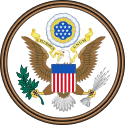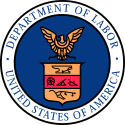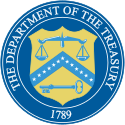Liste der Ministerien der Vereinigten Staaten
Die Ministerien der Vereinigten Staaten gehören zur Exekutive der Bundesregierung der Vereinigten Staaten. Die Ministerien werden durch die Minister (secretaries) geführt, die alle Mitglieder des traditionellen Kabinetts sind. Der Justizminister führt die Bezeichnung Generalstaatsanwalt (Attorney General) und vereint formell die Aufgaben die in anderen Staaten in Justizminister und Generalstaatsanwalt getrennt sind.
Die ersten drei Ministerien – Außenministerium, Kriegsministerium und Finanzministerium – wurden 1789 alle innerhalb weniger Wochen nach Schaffung der Bundesregierung errichtet. Ministerien werden vom Kongress durch Gesetz errichtet und aufgehoben. Der Ressortzuschnitt kann also nicht nach Gutdünken des Regierungschefs geändert werden wie in anderen politischen Systemen.
Die meisten Bundesbehörden sind einem der Ministerien zugeordnet. Ausnahmen sind die unabhängigen Behörden. Im präsidentiellen Regierungssystem der USA liegt in beiden Fällen die Exekutivgewalt beim Präsidenten.[1]
Die Ministerien
Aktuelle Ministerien
| Siegel | Ressort | Errichtung | Name | Veränderungen | Haushalt 2021 (2020) (Mrd. $) | Haushalt 2020 (Mrd. $) | Ref. |
|---|---|---|---|---|---|---|---|
| Äußeres | 1789 | U.S. Department of State | 40,8 | 52,5 | [2] | ||
| Finanzen | 1789 | U.S. Department of the Treasury | 17,69 | 17,2 | [3] | ||
| Inneres | 1849 | U.S. Department of the Interior | 21,56 | 24,3 | [4] | ||
| Justiz | 1870 | U.S. Department of Justice | 31,7 | 32,4 | [5] | ||
| Landwirtschaft | 1889 | U.S. Department of Agriculture | 151,0 | 153,0 | [6] | ||
| Handel | 1903 | U.S. Department of Commerce | ursprünglich Handel und Arbeit; Arbeit 1913 ausgegliedert | 7,9 | 12,2 | [7] | |
| Arbeit | 1913 | U.S. Department of Labor | 11,1 | 12,4 | [8] | ||
| Verteidigung | 1947 | U.S. Department of Defense | 740,5 | 738 | [9] | ||
| Gesundheit und Soziale Dienste | 1953 | U.S. Department of Health and Human Services | ursprünglich Gesundheit, Bildung und Wohlfahrt; Bildung 1979 ausgegliedert | 1.370,5 | 1.322,4 | [10] | |
| Wohnungsbau und Stadtentwicklung | 1965 | U.S. Department of Housing and Urban Development | 47,9 | 56,5 | [11] | ||
| Verkehr | 1966 | U.S. Department of Transportation | 89,0 | 87,0 | [12] | ||
| Energie | 1977 | U.S. Department of Energy | 35,36 | 31,7 | [13] | ||
| Bildung | 1979 | U.S. Department of Education | 66,6 | 72,7 | [14] | ||
| Kriegsveteranen | 1988 | U.S. Department of Veterans Affairs | 243,3 | 220,2 | [15] | ||
| Innere Sicherheit | 2002 | U.S. Department of Homeland Security | 49,79 | 51,22 | [16] | ||
| Gesamter Haushalt für Ministerien: | 2924,7 2883,72 | ||||||
Ehemalige Ministerien
| Siegel | Ressort | Name | Zeit | Veränderungen |
|---|---|---|---|---|
| Krieg | U.S. Department of War | 1789–1947 | als nachgeordnete Fachabteilung U.S. Department of the Army im Verteidigungsministerium aufgegangen | |
| Marine | U.S. Department of the Navy | 1798–1947 | als nachgeordnete Fachabteilung im Verteidigungsministerium aufgegangen | |
| Post | U.S. Post Office Department | 1872–1971 | als Bundesbehörde in den United States Postal Service umorganisiert | |
| Handel und Arbeit | U.S. Department of Commerce and Labor | 1903–1913 | in Handels- und Arbeitsministerium aufgeteilt | |
| Gesundheit, Bildung und Wohlfahrt | U.S. Department of Health, Education and Welfare | 1953–1979 | in Gesundheits- und Bildungsministerium aufgeteilt |
Die Minister
Die Secretaries werden vom Präsidenten mit Zustimmung des Senats ernannt.[17] Daher akzeptiert auch ein oppositioneller Senat im Regelfall, dass die Minister dem politischen Lager des Präsidenten angehören.
Seit 1972 sind die Minister nach Bundesgesetz auch für die Nachfolge des Präsidenten der Vereinigten Staaten vorgesehen und zwar ab der vierter Stelle nach dem Vizepräsidenten, dem Sprecher des Repräsentantenhauses und dem Senatspräsidenten pro tempore, dann in einer festgelegten Reihenfolge der Ministerien.
Weblinks
Einzelnachweise
- ↑ Artikel I, Abschnitt 1, Satz 1, Verfassung der Vereinigten Staaten von Amerika.
- ↑ Congressional Budget JustificationDepartment of State,Foreign Operations,and Related Programs. Department of State, abgerufen am 6. Februar 2021 (englisch).
- ↑ FY 2021 EXECUTIVE SUMMARY. Department of the Treasury, abgerufen am 6. Februar 2021 (englisch).
- ↑ Fiscal Year 2021The InteriorBudget in Brief. Department of the Interior, Februar 2020, abgerufen am 6. Februar 2021 (englisch).
- ↑ FY 2021Budget Request At A Glance. Department of Justice, abgerufen am 6. Februar 2021 (englisch).
- ↑ FY 2021 BUDGET SUMMARY. Department of Acriculture, abgerufen am 6. Februar 2021 (englisch).
- ↑ Department of Commerce Budget in Brief Fiscal Year 2021. Department of Commerce, abgerufen am 6. Februar 2021 (englisch).
- ↑ FY 2021 DEPARTMENT OF LABOR BUDGET IN BRIEF. Department of Labor, abgerufen am 6. Februar 2021 (englisch).
- ↑ DOD Releases Fiscal Year 2021 Budget Proposal. Department of Defense, 10. Februar 2020, abgerufen am 6. Februar 2021 (englisch).
- ↑ 2021 President’s Budget for HHS. Department of Health and Human Services, abgerufen am 6. Februar 2021 (englisch).
- ↑ BUDGET IN BRIEF. Department of Housing and Urban Development, abgerufen am 6. Februar 2021 (englisch).
- ↑ FY 2021 Budge Highlights. Department of Transportation, abgerufen am 6. Februar 2021 (englisch).
- ↑ FY 2021 Congressional Budget Request. Department of Energy, abgerufen am 6. Februar 2021 (englisch).
- ↑ Fiscal Year 2021 Budget Summary. Department of Education, abgerufen am 6. Februar 2021 (englisch).
- ↑ President’s Budget Request – Fiscal Year 2021. Department of Veterans Affairs, abgerufen am 6. Februar 2021 (englisch).
- ↑ Budget-in-BriefFiscal Year 2021. Department of Homeland Security, abgerufen am 6. Februar 2021 (englisch).
- ↑ Artikel I, Abschnitt 2, Verfassung der Vereinigten Staaten von Amerika.
Auf dieser Seite verwendete Medien
Seal of the United States Department of Homeland Security. A graphically styled American eagle appears in a circular blue field. The eagle's outstretched wings break through an inner red ring into an outer white ring that contains a circular placement of the words "U.S. DEPARTMENT OF" in the top half and "HOMELAND SECURITY" in the bottom half. The outer white ring has a silvery gray border. As in The Great Seal, the eagle’s left claw holds an olive branch with 13 leaves and 13 seeds while the right claw grasps 13 arrows. Centered on the eagle's breast is a shield divided into three sections containing elements that represent the homeland "from sea to shining sea." The top element, a dark blue sky, contains 22 stars representing the original 22 agencies and bureaus that have come together to form the department. The left shield element contains white mountains behind a green plain underneath a light blue sky. The right shield element contains four wave shapes representing the oceans, lakes and waterways alternating light and dark blue separated by white lines.
Seal of the United States Department of Housing and Urban Development.
The seal was originally unveiled on November 10, 1966, and later defined in law (Federal Register 32FR366-67 and 24 CFR subtitle A, §11.1, both since removed as part of a streamlining of the federal code). The seal was defined as:
On a white background within a circle composed of the words, "U.S. Department of Housing and Urban Development," is an eagle and two stars. The six upper bars depicting the upper portion of the eagle's wings, the torso of the eagle, the star at the right of the eagle, and the words, "U.S. Department of Housing and Urban Development," are colored blue. The eight lower bars depicting the lower portion of the eagle's wings and the star at the left of the eagle are colored green."
The seal is a representative of high rise buildings simulating an eagle and giving emphasis to the "urban" in HUD's name. The eagle (shown abstractly) is a symbol of Federal authority. The use of green symbolizes open space, land, growth and prosperity. The blue in the Seal alludes to the quality of life and environment in America's cities.
More information here.Autor/Urheber: TUBS
Lage von XY (siehe Dateiname) auf der Erde.
The seal of the United States Department of Health and Human Services. The symbol represents the American People sheltered in the wing of the American Eagle, suggesting the Department’s concern and responsibility for the welfare of the people. The colors are reflex blue and gold.
This seal is now just used for mainly legal purposes; the department has a separate logo which is used for its visual identity.
More information here and here.Seal of the United States Department of Education.
The seal was introduced on May 7, 1980, and is described in law as:More information here and 34 CFR Part 3.Standing upon a mound, an oak tree with black trunk and limbs and green foliage in front of a gold rising sun, issuing gold rays on a light blue disc, enclosed by a dark blue border with gold edges bearing the inscription "DEPARTMENT OF EDUCATION" above a star at either side of the words "UNITED STATES OF AMERICA" in smaller letters in the base; letters and stars in white.
Seal of the United States Department of Health, Education, and Welfare
Seal of the United States Department of Transportation, introduced on 17 November 1980. The seal is described in 49 CFR 3.1 as 'A white abstract triskelion figure signifying motion appears within a circular blue field. The figure is symmetrical. The three branches of the figure curve outward in a counter-clockwise direction, each tapering almost to a point at the edge of the field. Surrounding the blue circle is a circular ring of letters. The upper half of the ring shows the words “Department of Transportation”. The lower half of the ring shows the words “United States of America”. The letters may be shown in either black or medium gray. The official seal of the Department is modified when embossed. It appears below in black and white.'
The former seal of the now-defunct United States Department of War. It is now used as the seal of the United States Department of the Army. Can be found in: Benson John Lossing, ed. Harper's Encyclopedia of United States History (vol. 2) (New York, NY: Harper and Brothers, 1912). More information can be found here.
Seal of the United States Department of Justice.
The origins of the seal are unknown; it was first used in the 19th century as the seal for the Office of the Attorney General (prior to the formation of the Department of Justice) but the exact date is unknown. Even the translation of the Latin motto is murky, a matter of debate between Latin scholars. The Department's currently accepted translation is who prosecutes on behalf of Lady Justice, referring to the Attorney General. The motto is an allusion to the wording of the writ in a qui tam action: qui tam pro domino rege quam pro se ipso sequitur ("he who sues on behalf of our lord the King as well as for himself." The current-day seal dates from 1934, when some (though not all) of the heraldic mistakes on the original were corrected. More information here.Seal of the United States Department of the Navy (1879-1957)
Seal of the United States Department of the Interior.
The seal consists of a male bison with the head and body in a left position, standing on a prairie, with mountains and a rising sun in the background, enclosed within two concentric circles, having the words "U.S. Department of the Interior" and the date "March 3, 1849" (when Congress created the department) inscribed in the top and bottom arcs within these circles. See here for more information.
The bison seal dates from 1917, when it was used as the emblem on the initial department flag and thereafter replaced the old version of the seal, which used a federal eagle. The eagle was reinstated for a few years in the 1920s, and a different seal was used from 1968-69, but on both occasions the bison seal was reinstated. For more information see this chapter in The Department of Everything Else: Highlights of Interior History.Seal of the United States Department of State. It is mostly composed of the Great Seal of the United States.
Seal of the United States Department of Commerce.
The seal was approved on April 4, 1913 and is derived from the seal of the defunct United States Department of Commerce and Labor. It is composed of the arms (Per fesse azure and or, a ship in full sail on waves of the sea, in chief proper; and in base a lighthouse illumined proper), and crest ("The American Eagle displayed"). Around the arms, between two concentric circles, are the words "Department of Commerce" and "United States of America".
The official symbolism has been modified as the functions of the department have changed. As of 2007: the ship is a symbol of commerce; the blue denotes uprightness and constancy; the lighthouse is a well-known symbol representing guidance from the darkness which is translated to commercial enlightenment; and the gold denotes purity. The crest is the American bald eagle denoting the national scope of the Department's activities.
Full description at CFR Title 15 Part 1The seal of the United States Department of the Treasury.
The original seal dates from the Board of Treasury during the Articles of Confederation, and so predates the department (and Federal Government) itself. The current design is a slight simplification of the original, introduced in 1968.
The seal's arms depicts balancing scales (to represent justice), a key (the emblem of official authority) and a chevron with thirteen stars (to represent the original states).
For more information, see here.Seal of the former United States Department of the Post Office.
The creation of the new Department of Veterans Affairs in 1989 required a new official seal to represent VA. In November 1988, after the law establishing VA as a cabinet department was signed, VA initiated a competition among employees for a seal design that would give the new department a "new look." The winner of that competition, and creator of today's VA seal was David E. Gregory, a medical media production specialist at the Indianapolis VA Medical Center. These are the key elements of the seal, as he described them:
- The eagle represents the United States.
- The circle of five stars above the eagle represents the Army, Navy, Air Force, Marines and Coast Guard.
- The two flags in the eagle's talons represent the span of America's history from 13 colonies to the present 50 states.
- The flags are bound by a golden cord symbolic of those Americans who have fallen in service to their country.
- The eagle holds the cord to perpetuate the memory of those veterans who have fallen and sacrificed for the nation.
Seal of the United States Department of Defense from 2001 to 2022.
Seal of the former United States Department of Commerce and Labor
Seal of the United States Department of Agriculture.
The USDA seal was created in 1895. It was adapted for use as a general identifier in 1980, but those usages were replaced with the USDA Logo in 1996. The seal has been withdrawn from use as a departmental identifier, though it is still used on legal materials and other internal uses.
The seal is defined as:Two and three-eights inches in diameter (azure), a shock of corn (or), upon a base (vert) an American plough proper. All within a double annulet (argent), outer roped, inner beaded, charged with the inscription: UNITED STATES DEPARTMENT OF AGRICULTURE, and at the base, a scroll bearing the legend: "1862.AGRICULTURE IS THE FOUNDATION OF MANUFACTURE AND COMMERCE. 1889." (or). A diapered background of 44 stars (argent) for the States of the Union.
The dates on the scroll represent the year the Department was founded by act of Congress (1862), and the year the Department was made an Executive Office headed by a Secretary of cabinet rank (1889). The 44 stars represent the states in the Union in 1889.
See here and here for more information.





















